Surface Characterization and Performance Evaluation of Nitrogen Implanted Coinage Dies
Abstract
:1. Introduction
2. Materials and Methods
3. Results and Discussion
3.1. 14N Depth Profile
3.2. Die Hardness
4. Conclusions
Author Contributions
Funding
Institutional Review Board Statement
Informed Consent Statement
Data Availability Statement
Acknowledgments
Conflicts of Interest
References
- BÖHLER. Available online: https://www.bohler.at/export/en/ (accessed on 14 December 2021).
- VTT. Available online: https://www.vtt.de (accessed on 14 December 2021).
- Iwaki, M. Tribological Properties of Ion-implanted Steels. Mater. Sci. Eng. 1987, 90, 263–271. [Google Scholar] [CrossRef]
- Wang, T.M.; Li, B.Q.; Shi, J. The surface modification of 9Cr18 steel using nitrogen ion implantation. Surf. Coat. Technol. 1991, 50, 63–66. [Google Scholar] [CrossRef]
- Dryzek, J.; Wiezorek, J.; Wollschlager, S.; Lekki, J.; Gottdang, A.; Cleff, B. Studies of point defects and tribological properties of nitrogen-implanted stainless steel. Mater. Lett. 1991, 12, 16–20. [Google Scholar] [CrossRef]
- Bredell, L.J.; Malherbe, J.B. High dose implantation of nitrogen in tool steel: Auger electron spectroscopy and hardness measurements. Thin Solid Films 1993, 228, 267–271. [Google Scholar] [CrossRef]
- Rodrigo, M.; Jiménez, C.; Váquez, L.; Alonso, F.; Fernández, M.; Martínez-Duart, J. Influence of nitrogen implantation on the properties of Ti and substoichiometric TiNx films deposited on high speed steel. J. Mater. Res. 1998, 13, 2117–2122. [Google Scholar] [CrossRef]
- Li, M.; Knystautas, E.J.; Krishnadev, M. Enhanced microhardness of four modern steels following nitrogen ion implantation. Proc. SPIE 1998, 3413, 226–234. [Google Scholar] [CrossRef]
- Bobji, M.S.; Biswas, S.K. Estimation of hardness by nanoindentation of rough surfaces. J. Mater. Res. 1998, 13, 3227–3233. [Google Scholar] [CrossRef] [Green Version]
- Olofinjana, A.O.; Chen, Z.; Bell, J.M. Ultra-high surface hardness in nitrogen ion implanted low alloy steel. Mater. Lett. 2002, 53, 385–391. [Google Scholar] [CrossRef]
- Kumar, N.; Kataria, S.; Dash, S.; Srivastava, S.K.; Das, C.R.; Chandramohan, P.; Tyagi, A.K.; Nair, K.G.M.; Raj, B. Tribological properties of nitrogen ion implanted steel. Wear 2012, 274–275, 60–67. [Google Scholar] [CrossRef]
- Vlcak, P.; Fojt, J.; Weiss, Z.; Kopeček, J.; Perina, V. The effect of nitrogen saturation on the corrosion behaviour of Ti-35Nb-7Zr-5Ta beta titanium alloy nitrided by ion implantation. Surf. Coat. Technol. 2019, 358, 144–152. [Google Scholar] [CrossRef]
- Cisternas, M.; Bhuyan, H.; Retamal, M.J.; Casanova-Morales, N.; Favre, M.; Volkmann, U.G.; Saikia, P.; Diaz-Droguett, D.E.; Mändl, S.; Manova, D.; et al. Study of nitrogen implantation in Ti surface using plasma immersion ion implantation & deposition technique as biocompatible substrate for artificial membranes. Mater. Sci. Eng. C 2020, 113, 111002. [Google Scholar] [CrossRef]
- Piotrowska, K.; Madej, M.; Ozimina, D. Assessment of the Functional Properties of 316L Steel Alloy Subjected to Ion Implantation Used in Biotribological Systems. Materials 2021, 14, 5525. [Google Scholar] [CrossRef] [PubMed]
- Xie, X.; Chen, C.; Xu, J. Effect of Nitrogen Ion Implantation Energy on the Mechanical and Chemical Properties of AISI M50 Steel. Int. J. Chem. Eng. 2021, 2021, 4630661. [Google Scholar] [CrossRef]
- Lindhard, J.; Scharff, M.; Schiott, H.E. Range Concepts and Heavy Ion Ranges. Mat. Fys. Medd. Dan. Vid. Selsk. 1963, 33, 14. [Google Scholar]
- Ziegler, J.F.; Ziegler, M.D.; Biersack, J.P. SRIM—The stopping and range of ions in matter (2010). Nucl. Instrum. Methods Phys. Res. B 2010, 268, 1818–1823. [Google Scholar] [CrossRef] [Green Version]
- Ryssel, H.; Ruge, J. Ion Implantation; John Wiley & Sons: New York, NY, USA, 1986. [Google Scholar]
- Alves, E.; Lorenz, K.; Catarino, N.; Peres, M.; Dias, M.; Mateus, R.; Alves, L.C.; Corregidor, V.; Barradas, N.P.; Fonseca, M.; et al. An insider view of the Portuguese ion beam laboratory. Eur. Phys. J. Plus 2021, 136, 684. [Google Scholar] [CrossRef]
- Mayer, M.A. Improved Physics in SIMNRA 7. Nucl. Instrum. Methods Phys. Res. B 2014, 332, 176–180. [Google Scholar] [CrossRef]
- Weller, M.R. A deficiency method. In Handbook of Modern Ion Beam Materials Analysis; Wang, Y., Nastasi, M., Eds.; Materials Research Society: Warrendale, PA, USA, 2009; pp. 65–67. [Google Scholar]
- Cruz, J.; Silva, H.; Lopes, J.; Rocha, J.; Jesus, A.P. Very high fluence nitrogen implantations in metals studied by Rutherford Backscattering Spectrometry. Surf. Coat. Technol. 2018, 355, 169–173. [Google Scholar] [CrossRef]

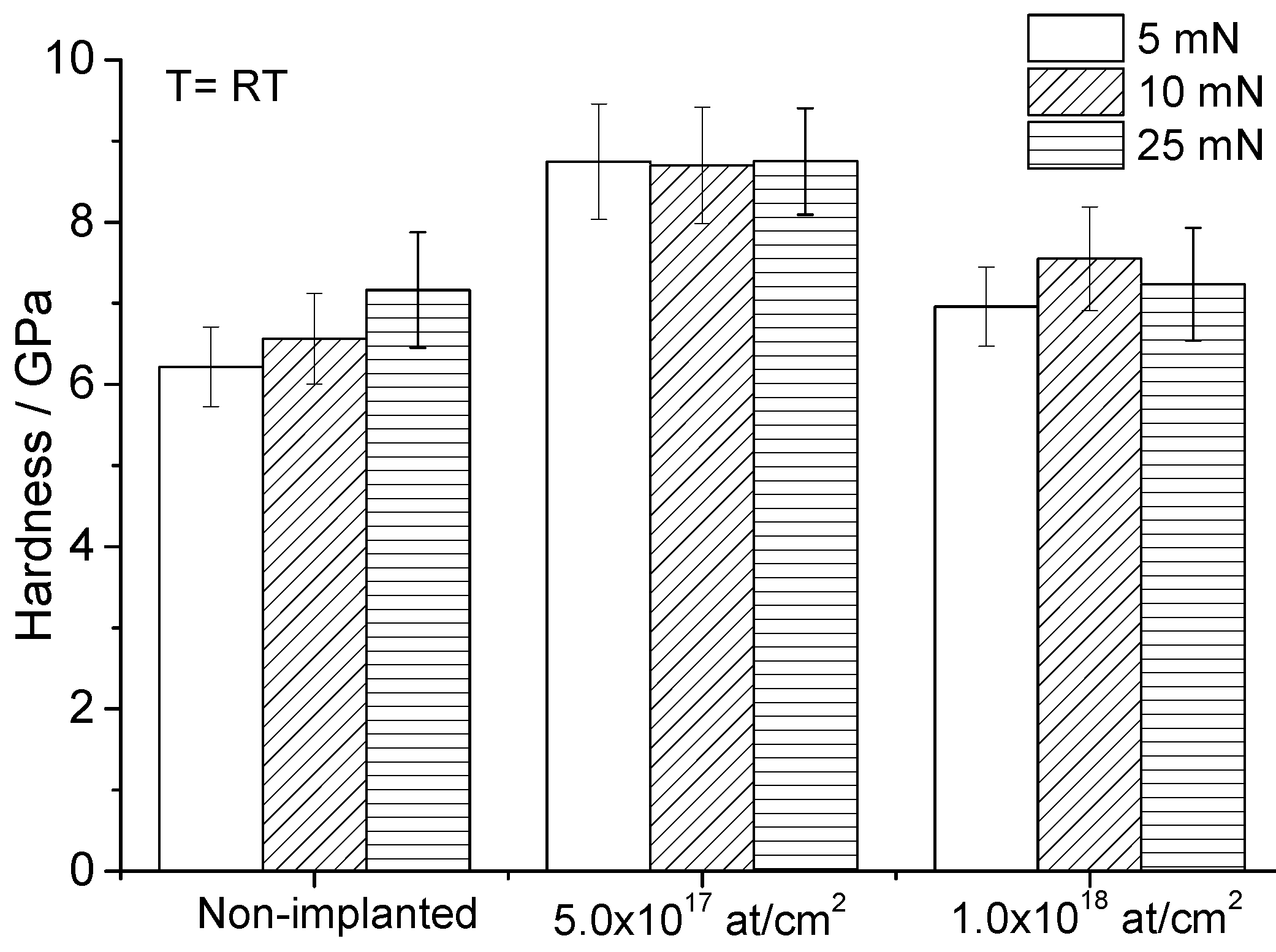
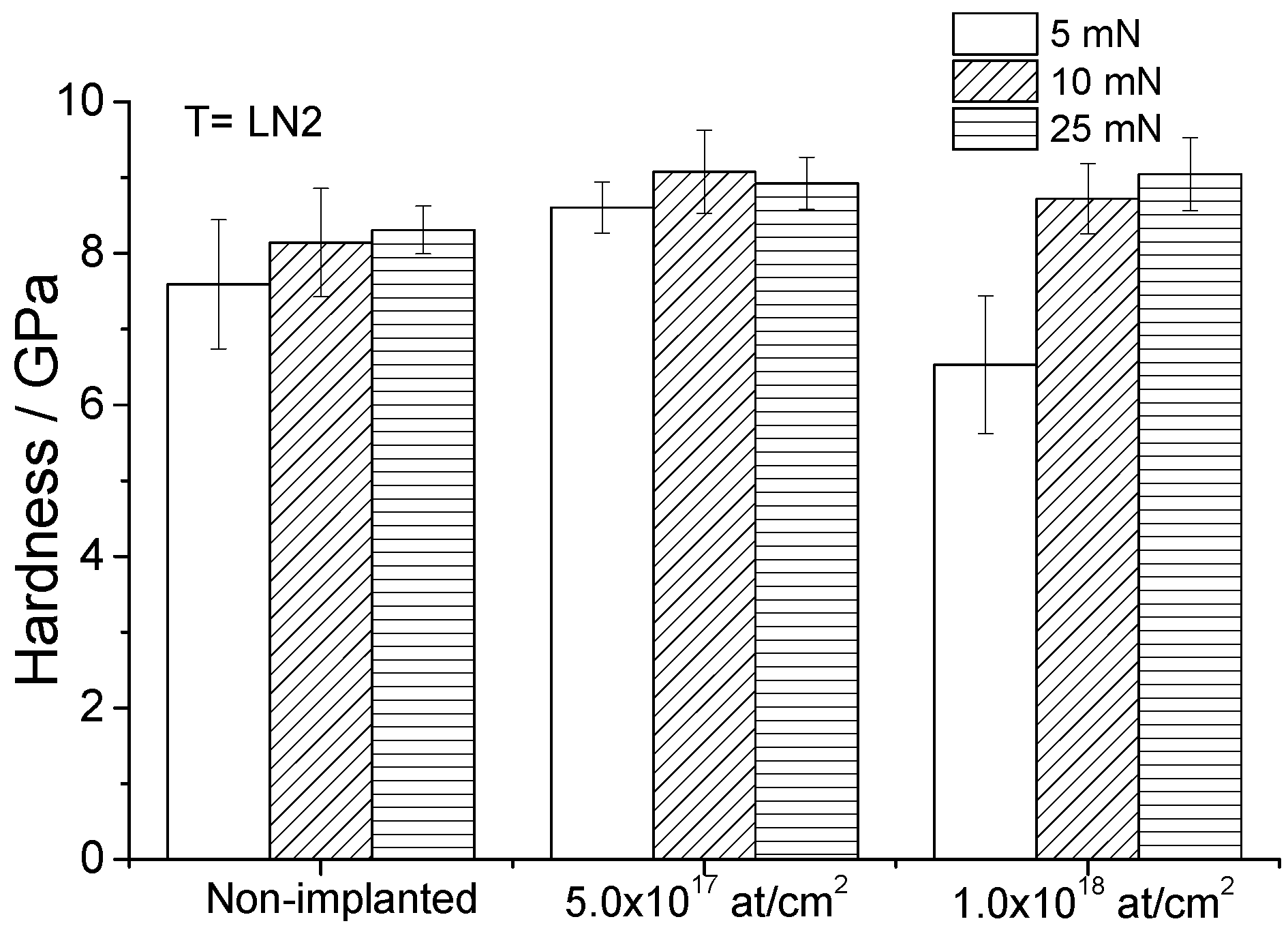
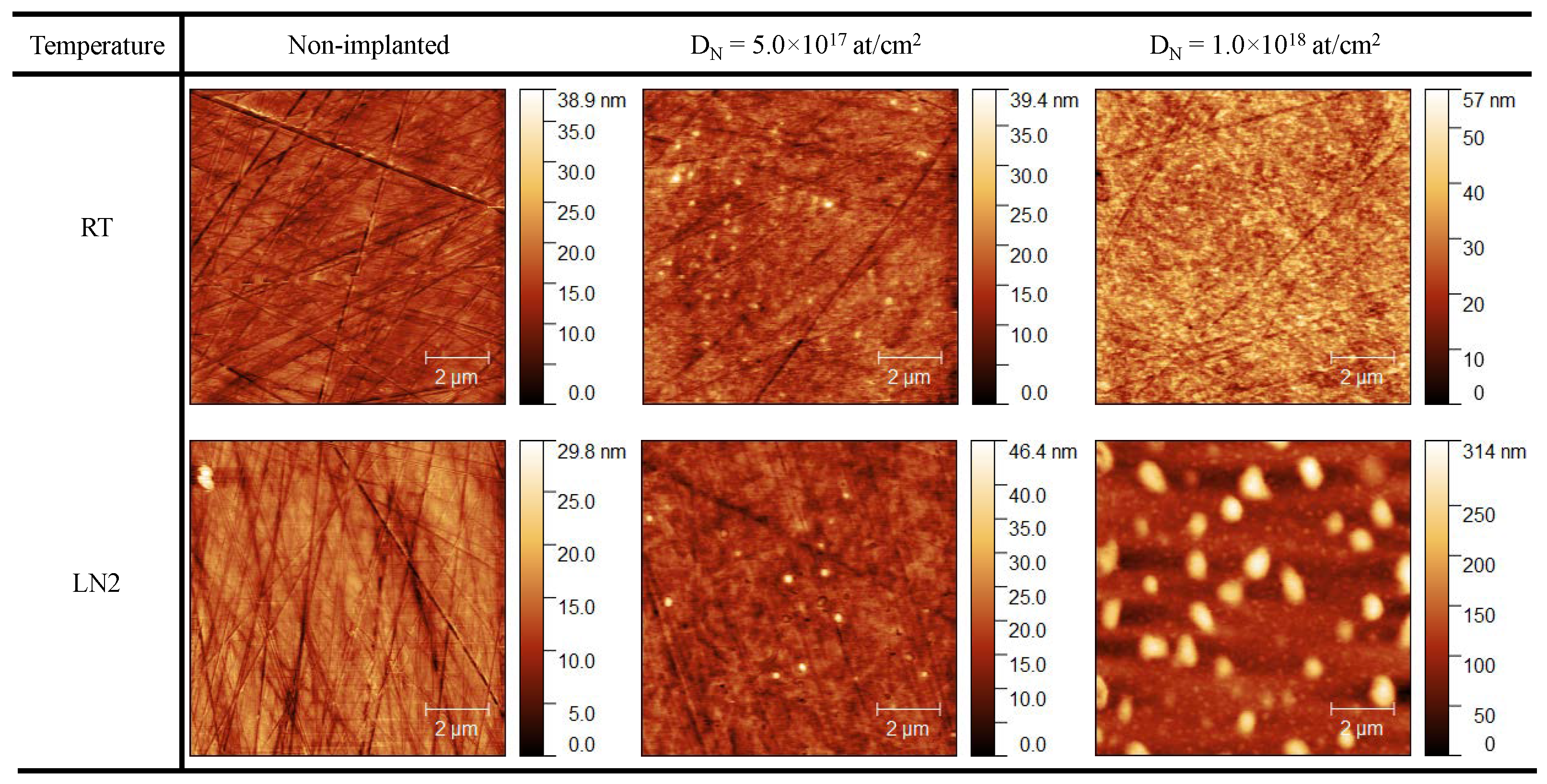
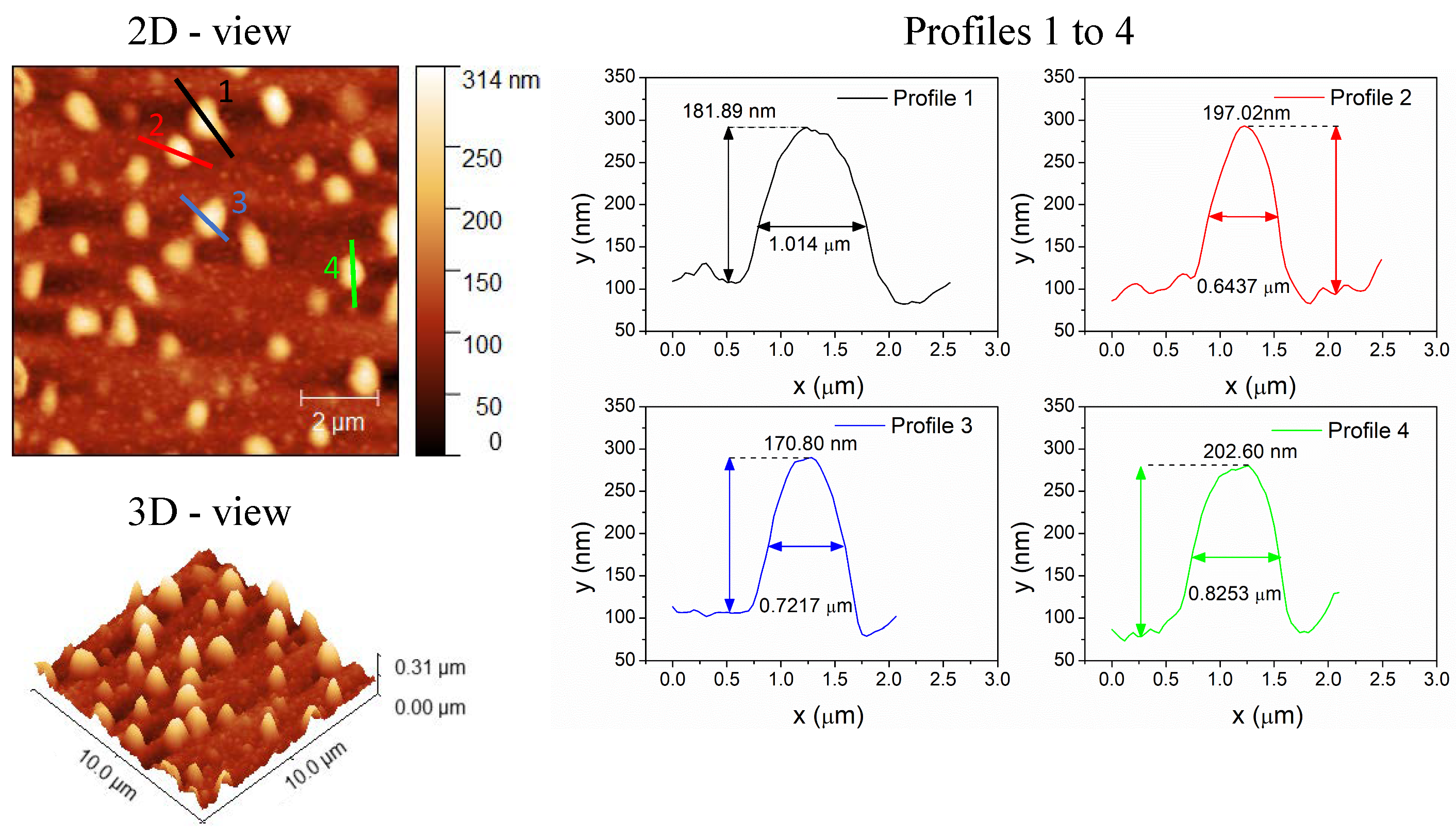
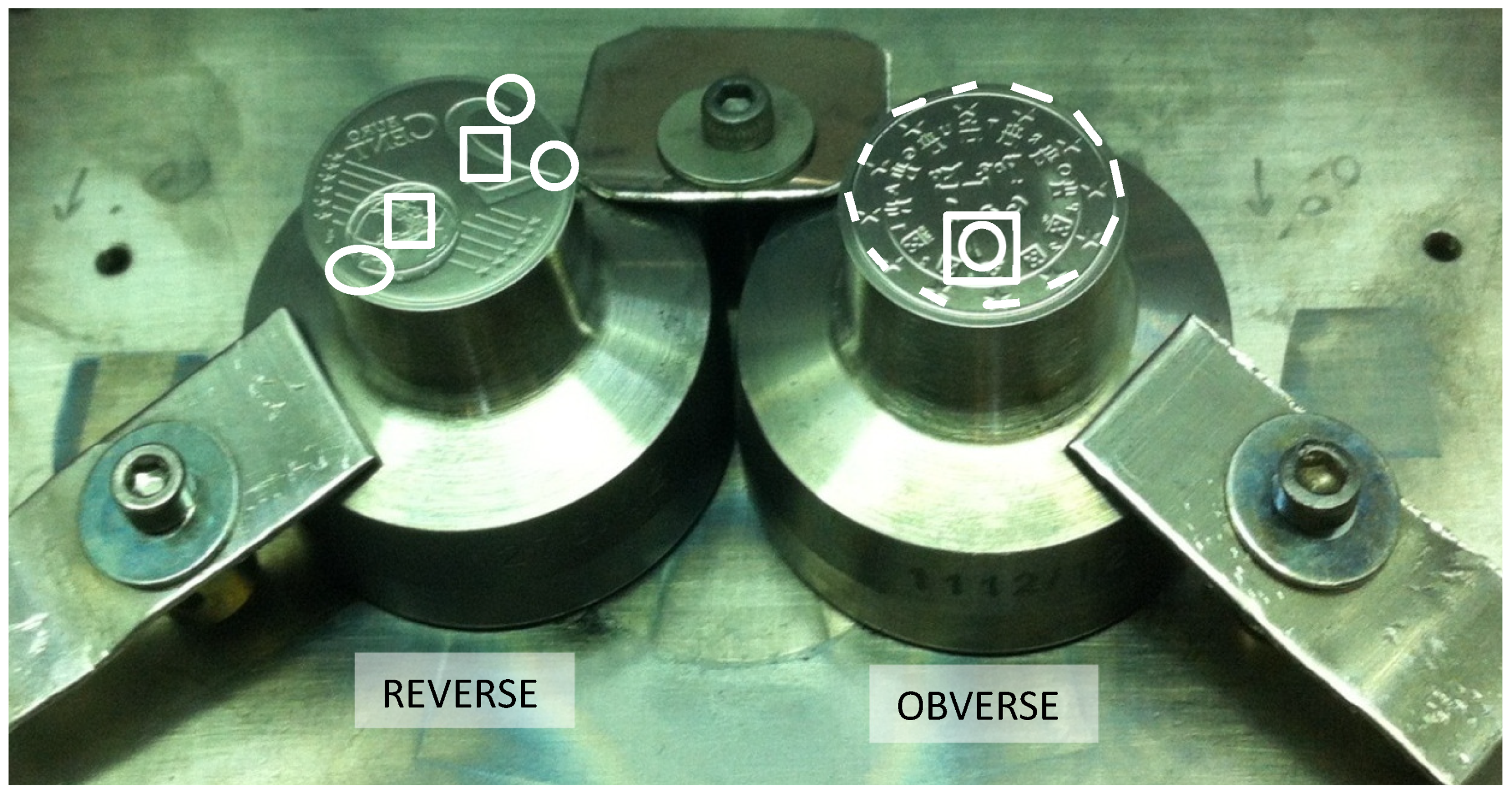
| C | Si | Mn | Cr | Mo | Ni | Fe |
|---|---|---|---|---|---|---|
| 0.55 | 0.30 | 0.40 | 1.00 | 0.25 | 3.00 | balance |
Publisher’s Note: MDPI stays neutral with regard to jurisdictional claims in published maps and institutional affiliations. |
© 2022 by the authors. Licensee MDPI, Basel, Switzerland. This article is an open access article distributed under the terms and conditions of the Creative Commons Attribution (CC BY) license (https://creativecommons.org/licenses/by/4.0/).
Share and Cite
Cruz, J.; Corregidor, V.; Nunes, B.; Alves, L.; Colaço, R.; Alves, E. Surface Characterization and Performance Evaluation of Nitrogen Implanted Coinage Dies. Processes 2022, 10, 479. https://doi.org/10.3390/pr10030479
Cruz J, Corregidor V, Nunes B, Alves L, Colaço R, Alves E. Surface Characterization and Performance Evaluation of Nitrogen Implanted Coinage Dies. Processes. 2022; 10(3):479. https://doi.org/10.3390/pr10030479
Chicago/Turabian StyleCruz, João, Victoria Corregidor, Bruno Nunes, Luís Alves, Rogério Colaço, and Eduardo Alves. 2022. "Surface Characterization and Performance Evaluation of Nitrogen Implanted Coinage Dies" Processes 10, no. 3: 479. https://doi.org/10.3390/pr10030479
APA StyleCruz, J., Corregidor, V., Nunes, B., Alves, L., Colaço, R., & Alves, E. (2022). Surface Characterization and Performance Evaluation of Nitrogen Implanted Coinage Dies. Processes, 10(3), 479. https://doi.org/10.3390/pr10030479








